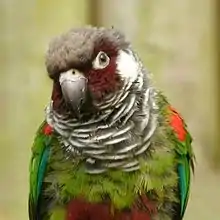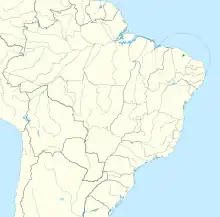Grey-breasted parakeet
The grey-breasted parakeet (Pyrrhura griseipectus) is an Endangered species of bird in subfamily Arinae of the family Psittacidae, the African and New World parrots. It is endemic to Ceará in northeastern Brazil.[3][4][1]
| Grey-breasted parakeet | |
|---|---|
 | |
| Scientific classification | |
| Domain: | Eukaryota |
| Kingdom: | Animalia |
| Phylum: | Chordata |
| Clade: | Dinosauria |
| Class: | Aves |
| Order: | Psittaciformes |
| Family: | Psittacidae |
| Genus: | Pyrrhura |
| Species: | P. griseipectus |
| Binomial name | |
| Pyrrhura griseipectus Salvadori, 1900 | |
 | |
| Synonyms | |
| |
Taxonomy and systematics
Until the early 2000s the grey-breasted parakeet was considered a subspecies of the white-eared parakeet (P. leucotis), which is also called maroon-faced parakeet. There is some thought that the specific epithet griseipectus should be replaced by anaca, which was originally applied to another parakeet, but which appears to have priority.[5]
Description
The grey-breasted parakeet is 20 to 23 cm (7.9 to 9.1 in) long. The sexes are the same. Adults have a brown crown, a plum-red face, and white ear coverts. Their upperparts are mostly green with a red-brown rump. Their chin, throat, and the sides of their neck are grayish with a scaly appearance. The center of their belly is red-brown and the rest of their underparts are green. Their wing is mostly green with a red shoulder and bluish flight feathers. Their tail is red-brown. Immatures are similar to adults.[5][6]
Distribution and habitat
The grey-breasted parakeet is found in only three sites, all in the Brazilian state of Ceará, though it formerly was known from as many as 15 locations. As of 2020, populations are known in Serra do Baturité, Quixadá, and Ibaretama. It inhabits patches of tall humid forest within otherwise dry caatinga and in granite- or sandstone-dominated areas. It is almost always found above 500 m (1,600 ft) of elevation.[5][1][6]
Behavior
Movement
The grey-breasted parakeet is not known to have any pattern of movement.[5]
Feeding
The grey-breasted parakeet forages for fruits and seeds in the forest canopy.[5]
Breeding
The grey-breated parakeet's breeding season is not fully known but does include February and March. It nests in cavities in trees and in rocks, and also uses nest boxes erected by conservation projects. The clutch size can be as high as seven eggs. The incubation period, time to fledging, and details of parental care are not known.[5]
Vocalization
The grey-breasted parakeet's call is a "piercing, fast, chattering 't'kreet-kreet-wik-kreet-krit'."[6]
Status
The IUCN originally assessed the grey-breasted parakeet as Critically Endangered but in 2017 revised the status to Endangered. It occupies very small enclaves and has an estimated population of between about 400 and 600 mature individuals. As a result of intensive conservation efforts including the provision of nest boxes the population is believed to be increasing at all three known locations. Most of what had been its forest habitat has been converted to agriculture, especially coffee farming. An ongoing threat is illegal trapping for the pet trade, both domestic and international, though the rate of it has apparently lessened since the early 2000s. The lack of natural nest cavities has somewhat been offset by the provision of nest boxes.[1][7]
References
- BirdLife International (2018). "Grey-breasted Parakeet Pyrrhura griseipectus". IUCN Red List of Threatened Species. 2018: e.T22733968A132181930. doi:10.2305/IUCN.UK.2018-2.RLTS.T22733968A132181930.en. Retrieved 8 March 2023.
- "Appendices | CITES". cites.org. Retrieved 4 March 2023.
- Gill, F.; Donsker, D.; Rasmussen, P., eds. (January 2023). "Parrots, cockatoos". IOC World Bird List. v 13.1. Retrieved 18 February 2023.
- Clements, J. F., T. S. Schulenberg, M. J. Iliff, T. A. Fredericks, J. A. Gerbracht, D. Lepage, S. M. Billerman, B. L. Sullivan, and C. L. Wood. 2022. The eBird/Clements checklist of birds of the world: v2022. Downloaded from https://www.birds.cornell.edu/clementschecklist/download/ retrieved November 10, 2022
- del Hoyo, J., N. Collar, G. M. Kirwan, and C. J. Sharpe (2020). Gray-breasted Parakeet (Pyrrhura griseipectus), version 1.0. In Birds of the World (J. del Hoyo, A. Elliott, J. Sargatal, D. A. Christie, and E. de Juana, Editors). Cornell Lab of Ornithology, Ithaca, NY, USA. https://doi.org/10.2173/bow.gybpar1.01 retrieved March 8, 2023
- van Perlo, Ber (2009). A Field Guide to the Birds of Brazil. New York: Oxford University Press. p. 126. ISBN 978-0-19-530155-7.
- Hennessey, Bennett. "In Brazil, The 'Nest-Best' Hope For Protecting Gray-Breasted Parakeets". 27 Dec 2018. Blog post. American Bird Conservancy. Accessed March 8, 2023
Further reading
- Ribas, C. C., L. Joseph, C. Y. Miyaki (2006). Molecular systematics and patterns of diversification in Pyrrhura (Psittacidae), with special reference to the picta-leucotis complex. The Auk 123(3): 660–680.
